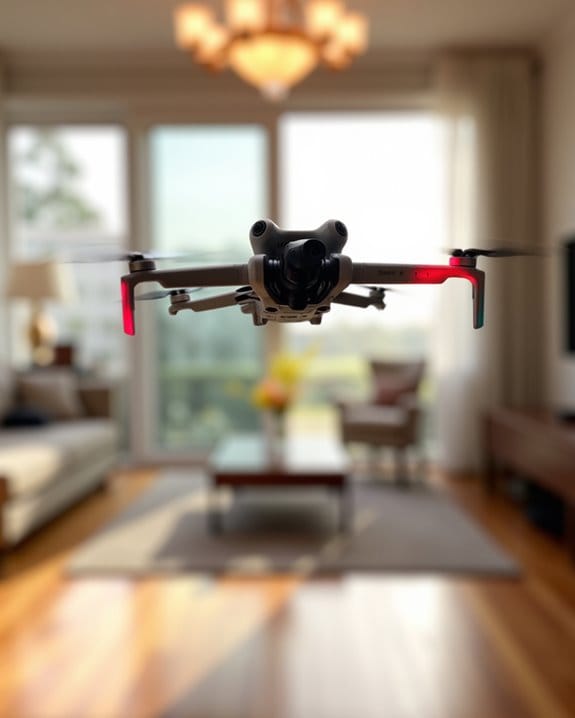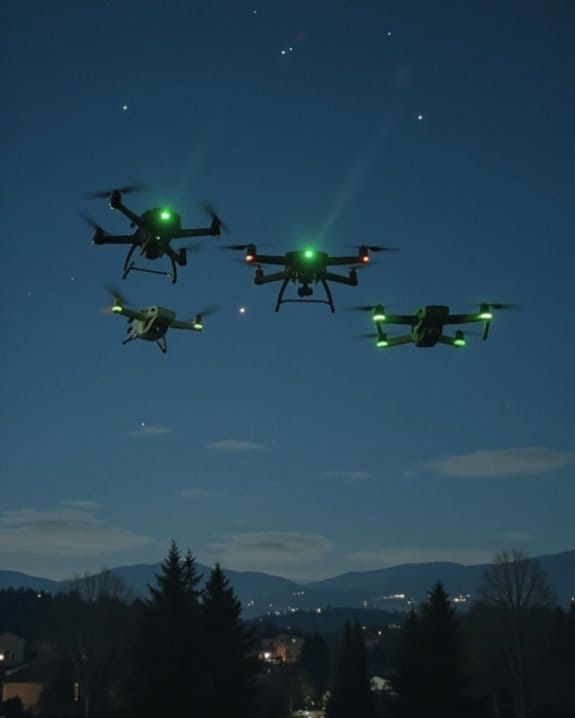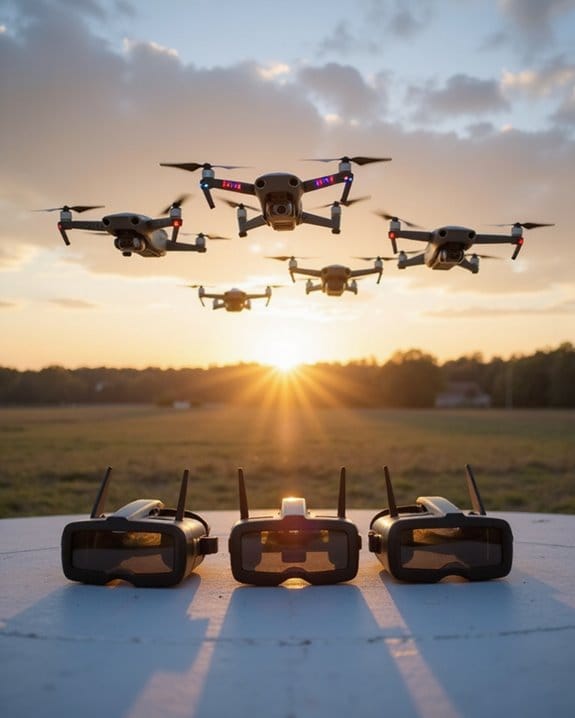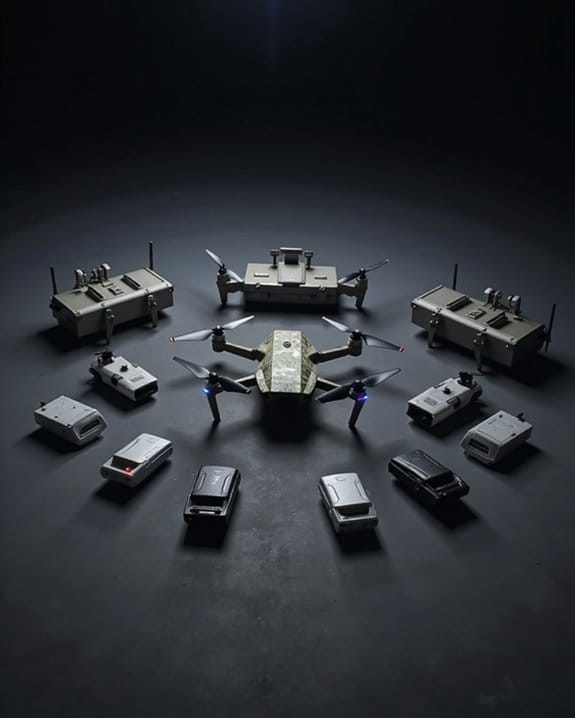For cinematic indoor flights in 2025, you’ll find exceptional performance in these three cinewhoop drones: The GEPRC CineLog35 V2 with its hollow carbon frame and SPEEDX2 motors offers professional-grade footage with O3 VTX integration. BETAFPV’s Air65 excels in tight spaces with its impact-absorbing canopy and 17.3g lightweight design. The BETAFPV Pavo Pico balances power and precision with 1102 14000KV motors and rubber-damped HD VTX mounting. Our detailed comparison reveals which model matches your specific indoor filming needs.
Key Takeaways
- GEPRC CineLog35 V2 offers professional-grade cinematic capabilities with quiet flight characteristics and aluminum reinforced structure ideal for indoor filming.
- BETAFPV Air65 excels in confined indoor spaces with its 65mm wheelbase, impact-absorbing canopy, and approximately 4-minute flight time from 1S batteries.
- BETAFPV Pavo Pico combines ultra-light design with vibration reduction features and 2S power configuration for smoother indoor footage.
- All three drones feature advanced flight controllers with high-precision gyroscopes that minimize image shake during indoor maneuvers.
- The best cinewhoop drones for 2025 prioritize durability with flexible components and reinforced frames while maintaining quiet flight operation.
GEPRC CineLog35 V2 HD O3 FPV Drone (PNP)
- New appearance design, strengthening carbon plate, hollow design, injection protection frame, noise reduction design, flight safety, silent,Adopts the GEP F722-45A AIO V2...
- CineLog35 v2 version integrated with O3 VTX. The CineLog35 V2 version of the main carbon plate and injection protection frame increased the 7075 aluminum column for...
- The battery mounting method uses a tie with 7075 aluminum parts fixed. The power XT60E1-M plug is integrated with the carbon plate for convenient application. The...
The GEPRC CineLog35 V2 stands out as the premier choice for filmmakers who need both cinematic quality and versatility in tight spaces. Its redesigned carbon frame with hollow construction delivers enhanced durability while maintaining remarkably quiet flight characteristics.
You’ll appreciate the integrated GEP F722-45A AIO V2 flight controller paired with the O3 VTX system, offering seamless connectivity. The SPEEDX2 2105.5 motors provide aggressive power response when you need it most.
Whether you’re filming indoors or outdoors, this 3.5-inch HD drone excels in cinematic, freestyle, and leisure applications. The aluminum reinforced structure and propeller guards with conveniently positioned memory card and USB ports make this a complete filming solution.
Best For: Professional filmmakers and enthusiasts seeking a compact yet powerful drone that excels in both indoor confined spaces and outdoor cinematic applications.
Pros:
- Integrated O3 VTX system with GEP F722-45A AIO V2 flight controller provides exceptional connectivity and performance
- Reinforced carbon frame with hollow design offers improved durability while maintaining quiet flight operation
- Versatile functionality for multiple filming styles including cinematic, freestyle, and leisure flying
Cons:
- PNP (Plug-and-Play) configuration requires additional components like a receiver to be fully operational
- 3.5-inch size may limit maximum flight time compared to larger drones
- Advanced features and power system might present a steeper learning curve for absolute beginners
BETAFPV Air65 Brushless Whoop Micro Drone with FPV Camera
- Ultralight Racing Whoop: Weighing in at just 17.3g, equipped with Air canopy, Air65 brushless whoop frame, 5IN1 Air brushless flight controller, ultra-lightweight...
- 5IN1 Air Brushless FC: The new 5IN1 Air brushless flight controller uses the G473 processor which has superior computing power and is equipped with an ICM42688P...
- Freestyle Propulsion Systems: For a smooth and elegant free flight experience, Freestyle version features 0702SE Ⅱ 23000KV brushless motors and HQ 31mm Ultralight...
Micro-sized but mighty, the BETAFPV Air65 stands out as an ultralight powerhouse for pilots seeking agility without sacrificing performance. At just 17.3g, this 65mm whoop delivers a remarkable 5.26:1 thrust-to-weight ratio that’ll make your indoor flights feel effortless.
The integrated 5IN1 flight controller packs impressive tech: G473 processor, ICM42688P gyro, and onboard 5.8GHz VTX with adjustable power. You’ll appreciate the redesigned Air canopy that absorbs impacts while protecting the C03 FPV camera.
With 0702SE II 23000KV motors spinning HQ 31mm props, you’ll get crisp response and approximately 4 minutes of flight time from the 1S 260/300mAh batteries.
Best For: Indoor FPV enthusiasts seeking an ultralight, high-performance micro whoop that offers exceptional maneuverability and freestyle capabilities in confined spaces.
Pros:
- Impressive 5.26:1 thrust-to-weight ratio provides exceptional agility and responsiveness for a micro drone
- Advanced 5IN1 flight controller with integrated VTX simplifies the design while delivering professional-grade performance
- Redesigned impact-resistant Air canopy offers superior protection and adjustable camera angles (25°-50°)
Cons:
- Limited 4-minute flight time may require multiple batteries for extended flying sessions
- 1S power system restricts potential power compared to larger multi-cell drones
- Ultralight 17.3g weight makes it potentially vulnerable to outdoor wind conditions
BETAFPV Pavo Pico ELRS Brushless Whoop Quadcopter (2S Cinewhoop)
- Pavo Pico ultra-light brushless whoop drone with the smallest wheelbase supports DJI O3 Air Unit. Explore more possibilities while ensuring HD image quality
- Due to Its split design HD VTX mounting bracket, Pavo Pico supports quick installation of DJI O3 HD digital VTX modules and a rubber damper vibration-damping design with...
- The battery slot and HD VTX mounting bracket duct height have been reduced to enhance the overall flying experience. DIY battery fixing methods are also supported, making...
Avid FPV pilots seeking the ultimate in compact cinematic drones will find their match in BETAFPV’s Pavo Pico. This ultra-light brushless whoop boasts the smallest wheelbase in its class while supporting the DJI O3 Air Unit for exceptional HD imagery.
The split design HD VTX mounting bracket guarantees quick installation, while rubber dampers reduce vibrations for GyroFlow stabilization compatibility. You’ll appreciate the F4 2S 20A AIO flight controller that weighs just 5.92 grams yet delivers impressive computing power and response speed.
Power comes from 1102 14000KV brushless motors paired with Gemfan 45mm props, all mounted on a durable PA12 frame for precise control.
Best For: Experienced FPV pilots and content creators looking for an ultra-compact cinewhoop capable of capturing high-definition footage with DJI O3 compatibility in tight spaces.
Pros:
- Extremely lightweight design with the smallest wheelbase in its class, making it ideal for flying in confined areas
- Split design with rubber dampers reduces vibrations for smooth HD footage compatible with GyroFlow stabilization
- Powerful 1102 14000KV brushless motors paired with Gemfan 45mm props deliver impressive performance for its size
Cons:
- Requires DJI O3 Air Unit to be purchased separately for HD video capabilities
- Advanced design likely presents a steep learning curve for beginners
- Limited battery slot size may restrict flight time options compared to larger models
Factors to Consider When Choosing a Cinewhoop

When shopping for your ideal cinewhoop drone, you’ll need to weigh several critical factors that directly impact your filming capabilities and overall experience. Your decision should account for the drone’s size and weight (affecting maneuverability), battery life (determining shooting duration), camera quality, frame durability, and motor performance. These key considerations will help you select a cinewhoop that matches your specific shooting style and creative needs rather than leaving you frustrated with limitations mid-project.
Size and Weight
The dimensions and heft of your cinewhoop drone greatly impact its performance characteristics and filming capabilities. When selecting the ideal model, pay close attention to these specifications:
- Wheelbase: Smaller designs (around 65mm) offer superior maneuverability in tight indoor spaces—perfect for maneuvering through doorways or around furniture.
- Weight: Lighter drones (under 20g) deliver extended flight times and quicker acceleration during complex shots.
- Size-to-weight ratio: Look for models approaching a 5:1 thrust-to-weight ratio for responsive handling and precise control.
The sweet spot for most cinewhoops falls between 65-100mm wheelbase, with smaller frames excelling in confined environments. Remember, a lighter craft won’t just extend your battery life—it’ll also provide better stability when dealing with unexpected air currents or when executing those dramatic reveal shots.
Flight Time
Beyond size and weight considerations, flight time represents a fundamental limiting factor in your cinewhoop’s shooting capabilities. Most cinewhoops operate between 4-7 minutes on a single charge, with battery capacity being the primary determinant.
When evaluating flight duration:
- Look for drones with 260mAh or larger batteries for adequate filming sessions
- Consider models with 2S battery configurations, which deliver more efficient power than 1S systems
- Pay attention to the thrust-to-weight ratio—drones with 5:1 or higher ratios maintain flight longer
- Evaluate the propulsion system’s efficiency, as better motors and props extend time aloft
Remember that manufacturer claims often reflect ideal conditions. For cinematic work, you’ll want at least 5 minutes of usable flight time to capture meaningful footage without constant battery swaps.
Camera Quality
Superior camera quality serves as the cornerstone of any worthwhile cinewhoop, determining the ultimate value of your aerial footage. When evaluating options, prioritize these key factors:
- High-definition capabilities – Look for cameras that deliver crystal-clear video, capturing every detail as you navigate tight indoor spaces
- Adjustable viewing angles (25-50° range ideal) – These allow you to customize your perspective based on shooting environment
- Lightweight design – Sub-2-gram cameras won’t compromise your drone’s agility or flight time
- Vibration dampening – Essential for smooth footage during those signature cinewhoop swoops and dives
- Stabilization features – Advanced stabilization compensates for turbulence, ensuring professional-quality results
Don’t be swayed by marketing hype – test footage speaks louder than specifications when evaluating a cinewhoop’s true camera performance.
Frame Durability
While camera quality captures stunning footage, your cinewhoop’s frame determines whether it’ll survive to fly another day. The best cinewhoop drones feature thoughtfully engineered frames that balance durability with necessary weight considerations.
Look for models incorporating high-strength alloys in their construction, which resist deformation even after inevitable crashes. Hollow frame designs offer the ideal compromise—reducing weight while maintaining structural integrity during repeated flights.
Your ideal choice should include:
- Flexible components that absorb impact forces
- Reinforced molding at critical stress points
- Integrated vibration-damping elements
Don’t be fooled by bulky frames that merely look tough. Modern cinewhoops utilize sophisticated materials that distribute crash forces evenly throughout the structure. This smart engineering prevents catastrophic failures even when you’re pushing flight boundaries in tight indoor spaces.
Motor Performance
Motors drive everything about your cinewhoop’s flight characteristics, from its ability to navigate tight spaces to how long it stays airborne. When selecting the perfect cinewhoop, pay close attention to KV ratings—they directly impact your drone’s speed and efficiency in confined areas.
Look for models with thrust-to-weight ratios exceeding 5:1 for ideal maneuverability. You’ll appreciate the quick response when filming in dynamic environments. Modern cinewhoops with high-efficiency motors can deliver up to 13% better propulsion, translating to extended flight times for those perfect shots.
Motor response time also matters greatly. Faster response means more stable footage, even during complex moves. The power output should match your filming style—whether you’re capturing smooth, slow pans or following fast-moving subjects through indoor spaces.
Compatible Air Units
The heart of your cinewhoop’s video transmission system lies in its air unit, which determines everything from footage quality to real-time monitoring capabilities. When selecting an air unit, prioritize these critical factors:
- Digital transmission protocols for high-definition video provide smoother, more stable footage during complex flight maneuvers
- Compatibility with your drone’s flight controller enables seamless integration—look for shared power systems and unified control interfaces
- Vibration-damping features minimize image shake, particularly vital when maneuvering tight indoor spaces
- Power-efficient designs extend your flight times while maintaining performance
- Adjustable mounting options allow for flexible camera angles, giving you creative freedom for varied shooting perspectives
Don’t overlook the importance of matching your air unit to your specific filming needs—the right choice can transform ordinary flights into cinematic masterpieces.
Control Response
Beyond capturing stunning visuals with your air unit, how your cinewhoop responds to your commands directly impacts footage quality and flight safety.
Look for drones with thrust-to-weight ratios exceeding 5:1 for immediate response during dynamic filming sequences. High-precision gyroscopes greatly reduce latency between your inputs and the drone’s movements—essential when maneuvering tight indoor spaces.
The best cinewhoops offer:
- Flight controllers with enhanced processing power
- Propulsion systems with 13%+ efficiency improvements
- Optimized motor-propeller combinations for minimal input delay
When testing a cinewhoop, pay attention to acceleration/deceleration capabilities. Quick but smooth changes between movements will elevate your footage from amateur to professional quality. Remember, responsive doesn’t mean twitchy—you want a drone that reacts promptly but maintains stable flight characteristics for those cinematic swoops through doorways.
Frequently Asked Questions
How Long Do Cinewhoop Drone Batteries Typically Last During Flight?
Cinewhoop drone batteries typically last 4-8 minutes during flight. You’ll get shorter times with aggressive flying or heavier cameras. Most pilots carry 3-5 batteries for a decent shooting session. Factors affecting flight time include:
- Drone weight
- Battery capacity (usually 450-850mAh)
- Flying style
- Wind conditions
- Camera payload
For extended sessions, you’ll want spare batteries and a proper charging station to keep the creativity flowing.
Can Cinewhoops Carry Action Cameras Like Gopro?
Like a featherweight boxer punching above its weight class, cinewhoops can indeed carry action cameras like GoPro. Most modern cinewhoops are specifically designed with mounting brackets for GoPros and similar cameras. You’ll find:
- Standard models handle GoPro Hero10/11
- Smaller cinewhoops work better with Session or Insta360 Go
- Camera weight affects flight time (expect 20-40% reduction)
- Consider “naked” GoPros to maximize flight duration
Are Cinewhoop Drones Suitable for Complete Beginners?
Cinewhoops aren’t ideal for complete beginners. You’ll face a steeper learning curve compared to larger, more stable drones. Their responsive controls and specialized design require some prior flying experience.
If you’re determined to start with a cinewhoop, choose a model with altitude hold, propeller guards, and beginner modes. Consider mastering a basic toy drone first, then upgrading once you’ve developed fundamental flight skills and spatial awareness.
What’s the Average Price Range for Quality Cinewhoop Drones?
Diving into your wallet won’t require deep-sea equipment for cinewhoop drones. You’ll typically invest between $300-$800 for quality models, with these price tiers:
- Entry-level: $300-400 (decent performance, basic features)
- Mid-range: $400-600 (improved stability, better cameras)
- Premium: $600-800+ (professional-grade cameras, advanced flight systems)
Your budget should align with your filming ambitions—beginners can start lower while professionals need the higher-end specifications.
Do I Need a License to Fly Cinewhoops Commercially?
Yes, you’ll need a license to fly cinewhoops commercially in the US. The FAA requires:
- Part 107 certification (Remote Pilot Certificate)
- Aircraft registration for drones over 0.55 pounds
- Adherence to commercial drone regulations
You’ll need to pass a knowledge test covering airspace rules, weather patterns, and operational procedures. Even smaller cinewhoops typically require licensing when used for paid work. Requirements vary internationally, so check your local aviation authority’s specific regulations.








